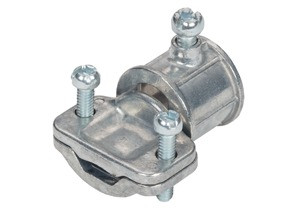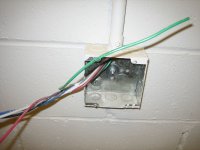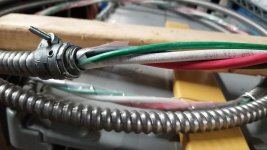Looking to run m/c through conduit, but stripping the metal sheath and pulling the conductors through the pipe. I can't find anywhere saying that isn't legal. My inspector said no to that cause by stripping the m/c it will void the listing of the m/c. To clear it up i am doing condos with metal studs, but they are keeping the ceilings exposed, so i am running m/c from my switch to the pipe coming into the stud cavity and then stripping the m/c and using the conduit as a chase to pull the wire to the light. So just want to see what others have done. They make conduit to m/c connectors, so just curious. Thanks
You are using an out of date browser. It may not display this or other websites correctly.
You should upgrade or use an alternative browser.
You should upgrade or use an alternative browser.
Stripping M/C cable
- Thread starter Rkoss05
- Start date
- Status
- Not open for further replies.
- Location
- Bremerton, Washington
- Occupation
- Master Electrician
If stripping the jacket voids the UL listing how is it possible to use MC cable at an outlet box?
PaulMmn
Senior Member
- Location
- Union, KY, USA
- Occupation
- EIT - Engineer in Training, Lafayette College
Is this the same issue as with Romex? I know you can't strip Romex and use the conductors separately-- Romex is labeled with the wire gauge and rating; the individual conductors are not.
- Location
- New Jersey
- Occupation
- Journeyman Electrician (retired)
winnie
Senior Member
- Location
- Springfield, MA, USA
- Occupation
- Electric motor research
Many MC conductors are individually labeled so stripping off the insulation is not an issue.
This is my understanding of the key issue.
Cable assemblies are listed as cable assembles and need to be used as such, otherwise you violate their listing. This includes stripping the necessary lengths at the end to make connections in junction boxes, but doesn't include stripping the entire sheath off to run the conductors in a conduit.
However if the conductors inside of the cable assembly are themselves suitably marked, then they are also individually listed for use as conductors.
So doing what the OP wants to do is nominally prohibited but generally acceptable because MC cable is often made up of conductors that are appropriately listed and labeled. On the other hand, NM cable generally doesn't have individually labeled conductors and thus is generally prohibited to do the same thing.
The OP would need to have the supplier ensure that the MC they get is properly labeled and then go back to the inspector.
Here is a photo of some random 8/3 MC in my basement. The sheath could be stripped and the conductors used as XHHW:
Attachments
- Location
- Tennessee NEC:2017
- Occupation
- Semi-Retired Electrician
@PaulMmnIs this the same issue as with Romex? I know you can't strip Romex and use the conductors separately-- Romex is labeled with the wire gauge and rating; the individual conductors are not.
Please update your profile to include your occupation.
winnie
Senior Member
- Location
- Springfield, MA, USA
- Occupation
- Electric motor research
Unlike NM, MC conductors are individually identified as THHN/THWN, (you can find this on all manufacturers web sites) so they can be used as THHN/THWN conductors
I'm pretty sure I've seen MC cable where the conductor identification was on a little strand of tape twisted in with the conductors, and not on the conductors themselves.
-Jon
macmikeman
Senior Member
- Location
- Planet macmikeman
People that find issue with the practice have way too much time on their hands........... They make a fitting just for this exact purpose. Listed fitting.......
Behold a Bridgeport Exhibit A.

Behold a Bridgeport Exhibit A.

electrofelon
Senior Member
- Location
- Cherry Valley NY, Seattle, WA
- Occupation
- Electrician
Yeah stuff like this drives me crazy. Aren't there more important things for inspectors to look at than these ridiculous supposed "listing violations"??People that find issue with the practice have way too much time on their hands........... They make a fitting just for this exact purpose. Listed fitting.......
Behold a Bridgeport Exhibit A.
- Location
- New Jersey
- Occupation
- Journeyman Electrician (retired)
I agree. Someone should write a PI stating that running the conductors in a raceway without the sheath is code compliant. We've been doing that for decades without any issues.Yeah stuff like this drives me crazy. Aren't there more important things for inspectors to look at than these ridiculous supposed "listing violations"??
Strathead
Senior Member
- Location
- Ocala, Florida, USA
- Occupation
- Electrician/Estimator/Project Manager/Superintendent
Agreed, this is what it is. Another example of the arbitrary nature of the code. The code now REQUIRES NM to be constructed of 90 degree insulation conductors, but the lack of marking means you can't use them as individual conductors. The more I teach the code (as a 2nd year instructor) the more things I run across that are frustrating.Unlike NM, MC conductors are individually identified as THHN/THWN, (you can find this on all manufacturers web sites) so they can be used as THHN/THWN conductors
Thanks for the input. Yes I know that Romex can't be stripped and ran down a pipe, due to the fact the conductors don't have a rating on them, but how many of us do that still like in residential basements? M/c has ratings on each conductor to make it legal to run in pipe since each individual wire has a rating. I just wanted to see if anyone ran into this before and some solutions. Thanks!!
People that find issue with the practice have way too much time on their hands........... They make a fitting just for this exact purpose. Listed fitting.......
Behold a Bridgeport Exhibit A.
Oddly enough this always looked like an EMT to Romex connector to me.
JAP>
winnie
Senior Member
- Location
- Springfield, MA, USA
- Occupation
- Electric motor research
IMHO the solution comes out of the Dale Carnegie approach. You need to get the inspector on your side with this.
So you tell the inspector that they are correct! You researched this further and you now understand that in general you cannot run conductors stripped out of cable assemblies in conduit. Additionally (don't say 'but', say 'and', because the 'but' is negating the first sentence; you want to show hot the next thing _adds_ to the first sentence) it turns out that some MC cable is manufactured using inner conductors which are suitably rated and marked so that they can be run in conduit. Because transitioning from cable to conduit (avoiding a splice and junction box) is so desirable, manufacturers have provided a product which permits this while addressing the legitimate concern of having the wrong conductors in the conduit.
Then show the inspector links to MC cable with the appropriate markings, links to the appropriate transition fittings, etc. If possibly also show links to the 'wrong' way of doing it (MC cable without appropriate markings), transitions done by assembling fittings in unlisted fashion, etc.
The point is that you don't want to call the inspector wrong, instead you want to build on their innate desire to be correct in their concerns but you have a solution which does exactly what you wanted to do in the first place while at the same time agreeing with their concerns.
(We can have a deeper debate here as to weather it really matters about the markings on the wire or the use of rigid couplers to combine fittings intended for locknuts.... If the inspector is the sort that actually likes discussion and learning, send them to this forum!)
-Jon
So you tell the inspector that they are correct! You researched this further and you now understand that in general you cannot run conductors stripped out of cable assemblies in conduit. Additionally (don't say 'but', say 'and', because the 'but' is negating the first sentence; you want to show hot the next thing _adds_ to the first sentence) it turns out that some MC cable is manufactured using inner conductors which are suitably rated and marked so that they can be run in conduit. Because transitioning from cable to conduit (avoiding a splice and junction box) is so desirable, manufacturers have provided a product which permits this while addressing the legitimate concern of having the wrong conductors in the conduit.
Then show the inspector links to MC cable with the appropriate markings, links to the appropriate transition fittings, etc. If possibly also show links to the 'wrong' way of doing it (MC cable without appropriate markings), transitions done by assembling fittings in unlisted fashion, etc.
The point is that you don't want to call the inspector wrong, instead you want to build on their innate desire to be correct in their concerns but you have a solution which does exactly what you wanted to do in the first place while at the same time agreeing with their concerns.
(We can have a deeper debate here as to weather it really matters about the markings on the wire or the use of rigid couplers to combine fittings intended for locknuts.... If the inspector is the sort that actually likes discussion and learning, send them to this forum!)
-Jon
IMHO the solution comes out of the Dale Carnegie approach. You need to get the inspector on your side with this.
So you tell the inspector that they are correct! You researched this further and you now understand that in general you cannot run conductors stripped out of cable assemblies in conduit. Additionally (don't say 'but', say 'and', because the 'but' is negating the first sentence; you want to show hot the next thing _adds_ to the first sentence) it turns out that some MC cable is manufactured using inner conductors which are suitably rated and marked so that they can be run in conduit. Because transitioning from cable to conduit (avoiding a splice and junction box) is so desirable, manufacturers have provided a product which permits this while addressing the legitimate concern of having the wrong conductors in the conduit.
Then show the inspector links to MC cable with the appropriate markings, links to the appropriate transition fittings, etc. If possibly also show links to the 'wrong' way of doing it (MC cable without appropriate markings), transitions done by assembling fittings in unlisted fashion, etc.
The point is that you don't want to call the inspector wrong, instead you want to build on their innate desire to be correct in their concerns but you have a solution which does exactly what you wanted to do in the first place while at the same time agreeing with their concerns.
(We can have a deeper debate here as to weather it really matters about the markings on the wire or the use of rigid couplers to combine fittings intended for locknuts.... If the inspector is the sort that actually likes discussion and learning, send them to this forum!)
-Jon
All while the General Contractor, his Job Foreman, and 10 Sheetrockers are barking at you to get your crap in the wall and get out of the way.
JAP>
electrofelon
Senior Member
- Location
- Cherry Valley NY, Seattle, WA
- Occupation
- Electrician
I think it's more of a product standard issue. For some reason the product standard doesn't explicitly require thhn inners for NM.Agreed, this is what it is. Another example of the arbitrary nature of the code. The code now REQUIRES NM to be constructed of 90 degree insulation conductors, but the lack of marking means you can't use them as individual conductors. The more I teach the code (as a 2nd year instructor) the more things I run across that are frustrating.
Strathead
Senior Member
- Location
- Ocala, Florida, USA
- Occupation
- Electrician/Estimator/Project Manager/Superintendent
It explicitly requires 90 degree insulation.I think it's more of a product standard issue. For some reason the product standard doesn't explicitly require thhn inners for NM.
334.112 Insulation. The insulated power conductors shall be
one of the types listed in Table 310.104(A) that are suitable for
branch-circuit wiring or one that is identified for use in these
cables. Conductor insulation shall be rated at 90°C (194°F).
electrofelon
Senior Member
- Location
- Cherry Valley NY, Seattle, WA
- Occupation
- Electrician
Sure, I dont dispute that. What I was trying to say is it's not really the codes fault that NM has these undefined inners that we can't use separately. I mean I guess they could add NM inner conductors to the list of other acceptable conductors..... But personally I like well-defined things and would like the inners to be thhn, officiallyIt explicitly requires 90 degree insulation.
334.112 Insulation. The insulated power conductors shall be
one of the types listed in Table 310.104(A) that are suitable for
branch-circuit wiring or one that is identified for use in these
cables. Conductor insulation shall be rated at 90°C (194°F).
- Status
- Not open for further replies.



